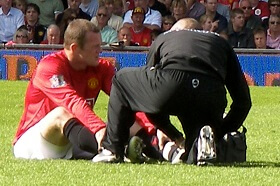- Home
- Common Foot Problems
- Stress Fractures
Stress Fracture Foot Problems
Written By: Chloe Wilson BSc(Hons) Physiotherapy
Reviewed By: FPE Medical Review Board
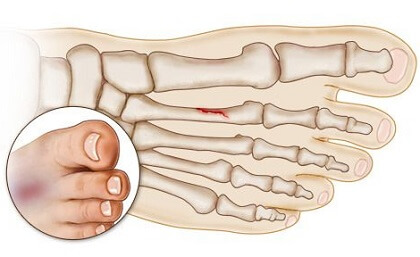
Stress fracture foot problems develop when there is a small break in one of the foot bones.
They most commonly occur due to repetitive overloading of the foot in sports.
In many cases the actual fracture may be extremely small, the width of a single hair, but they can also be extremely painful.
When treated correctly stress fractures usually heal quickly, but if they are left untreated they can become a serious problem, leading to chronic pain and stiffness.
How Do Foot Stress Fractures Occur?
Foot stress fractures develop when the foot is repeatedly over-loaded placing too much force through the foot bones. It is typically the repetitive action of the foot striking the floor that leads to foot stress fractures with activities such as football, tennis, gymnastics and basketball. Runners are also commonly affected.
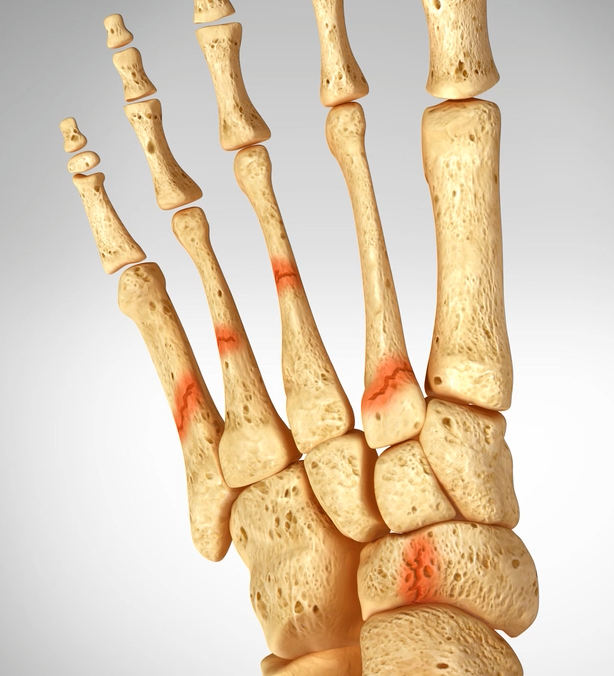
Stress fractures foot problems usually affect people who have suddenly increased their activity levels, whether it be that they’ve taken up a new sport or have suddenly increased their training levels, be it the intensity, duration or frequency. This causes two problems:
Firstly, the muscles in the foot do not have the strength and endurance needed to cope with the increased activity levels and are unable to provide the support needed to the foot bones. This leads to excessive force going through the bones which can cause a crack in the bone.
Secondly, the bones in our body are continually regenerating. Old bone is reabsorbed and new bone is formed – this is quite normal. When too much force goes through the bones, the new bone growth is unable to keep up with bone reabsorption leading to small cracks in the bone.
What Causes Foot Stress Fractures?
As we have already seen, stress fracture foot problems typically affect athletes, particularly if the have recently increased training levels or taken up a new sport. There are also other factors that increase the risk of stress fractures foot problems:
- Gender: foot stress fractures more commonly affect women.
This is thought to be due to reduced oestrogen levels which can weaken the
bones, especially in those with an irregular menstrual cycle
- Age: Adolescents are often affected by foot stress fracture problems as their bones are still growing and therefore aren’t as strong
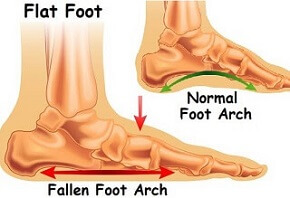
- Abnormal Foot Biomechanics: Incorrect foot positions such as reduced foot arch height can place more force through certain foot bones increasing the risk of stress fracture foot problems
- Previous Stress Fractures: More than half of all stress fracture foot sufferers will have had at least one previous fracture
- Poor Footwear: Shoes that are too stiff or lack support increase the risk of bone damage
- Changing Training Surface: Suddenly switching the surface you regularly train on e.g. from grass to concrete can increase the risk of stress fracture foot problems occurring
- Osteoporosis: This reduces bone strength and density increasing the risk of fracture
Where Do Stress Fractures Occur?
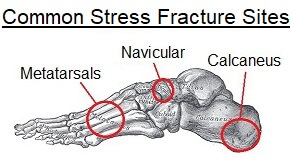
Stress fractures of the foot typically affect the metatarsals, calcaneus (heel), navicular and fibula (outer shin). To find out more, visit the foot bones anatomy section.
The most common type is a metatarsal stress fracture, also known as a March Fracture because they commonly occur in soldiers and hikers.
Stress Fracture Foot Symptoms
The most common symptoms of a stress fracture of the foot are:
- Pain: A stress fracture foot problem usually starts off with mild pain and gradually gets worse. The pain tends to come on during exercise and eases off with rest. As things progress, pain tends to come on quicker and lasts longer until it affects everyday activities like walking and standing to the point where there is little respite from the pain
- Swelling: There may be some swelling around the area of the fracture which gets worse with activity and improves with rest. In some cases there may be a hard lump on top of foot
- Tenderness: It might be tender to touch the area of the stress fracture
How Do You Detect A Stress Fracture?
Stress fracture foot problems can be diagnosed by your doctor. By talking about you activity levels, work and any medications you are on, as well as carrying out a physical examination, your doctor will be able to identify a stress fracture of the foot.
Your doctor may send you for an MRI scan or bone scan to confirm the diagnosis. X-rays are rarely done as they tend not to be sensitive enough to detect a foot stress fracture until it has begun to heal and the new bone growth shows up on the x-ray.
Treatment For Foot Stress Fractures
The goal of treatment for stress fracture foot problems is to reduce the pain and inflammation and allow the bone to fully heal so you can return to activity. Treatment for foot stress fractures usually consists of:
- Rest: The most important thing to do if you are suffering from stress fracture foot problems is to rest. Failure to do so can lead to a more complex fracture (break) of the bone. Stop the activity that caused the pain to start in the first place, typically for 6-8 weeks to allow the fracture to heal. You can continue exercising, as long as you aren’t placing excess pressure through the foot – try activities like swimming and cycling.

- Ice: Using ice regularly helps to reduce pain and
inflammation. Apply an ice pack wrapped
in a towel to the affected area for 10-15 minutes, every couple of hours.
Visit the Ice Treatment section to find out how to safely and effectively use ice. Ice is most helpful in the first couple of weeks. - Elevation: As long as there is swelling, try regularly keeping the foot elevated, ideally above the level of the heart can help to reduce it.
- Braces: You may be advised to wear a special walking shoe or brace to reduce the force going through the foot. In severe cases, you may need a splint or cast.
- Crutches:
Crutches may be advised to help you keep your weight off the affected foot for
a couple of weeks. Usually after this
you can start weight bearing again as this actually helps stimulate healing.
- Medication: Your doctor may prescribe drugs like Paracetamol or Tylenol (acetaminophen) to help relieve pain. These tend to be more appropriate than drugs such as ibuprofen (e.g. Advil or Neurofen) or naproxen as there has been some research suggesting that these can actually delay bone healing.
- Surgery: Stress fracture foot problems rarely require surgery but if the fracture fails to heal, surgery may be indicated.
Returning To Activities
It is important not to return to your usual activities too quickly following stress fracture foot problems otherwise the fracture may not heal properly and you’ll be back to square one. Avoid the activity that caused the injury for approximately 6-8 weeks or longer if necessary until you are completely pain-free.
Pace yourself when you return to activity. Start slowly and gradually increase the intensity, duration and frequency. Ideally, start with non-weight bearing activities such as swimming and cycling before starting high-impact activities. If the pain returns, stop immediately.
How To Prevent Stress Fractures
As always, prevention is better than cure. Stress fracture foot problems frequently recur with approximately sixty percent of stress fractures sufferers having had a previous fracture.
Here are some top tips on how to reduce the risk of suffering from a stress fracture in your foot:
- Exercise
Progression: when starting new activities or when you want to up training
schedules, do so slowly. Follow the 10%
rule – do not increase the intensity or duration of exercise by more than 10%
per week. This allows your body to adapt
to the increased expectations on it.
Make sure you warm up and stretch before exercise and take regular
breaks
- Footwear:
Make sure you are wearing comfortable, supportive footwear that fits
properly. If you have abnormal foot
biomechanics such as high or fallen arches, talk to your doctor about whether
you would benefit from foot orthotic insoles
- Vary Exercise: Vary the type of exercise that you do to help avoid repetitive stresses on the same part of your feet
- Diet: Ensure you are getting plenty of Calcium and Vitamin D in your diet to help keep your bones strong
- Exercises: Strengthening the muscles around the foot and ankle can help reduce muscle fatigue and improve bone density reducing the risk of stress fracture foot problems. Visit the foot and ankle exercises section to find out more
Stress Fracture Foot Summary
Stress fracture foot problems are a common cause of foot pain in athletes.
Stress fractures usually develop gradually and are often linked to sudden increases in the intensity, frequency and duration of exercise.
When the foot bones are repeatedly overloaded, small cracks can form as the bone isn't strong enough to cope.
Foot stress fractures are often linked to abnormal foot biomechanics, previous foot injuries, unsupportive footwear, gender and age.
Stress fracture foot problems typically affect the metatarsal, navicular or calcaneus bones.
Treatment for foot stress fractures usually involves a combination of rest, ice, elevation, braces or walking boots, crutches and medication.
If this is not sounding quite like your problem, visit the foot pain diagnosis section for help working out what is wrong or you may be interested in the following articles:
Related Articles
Page Last Updated: 05/12/23
Next Review Due: 05/12/25
